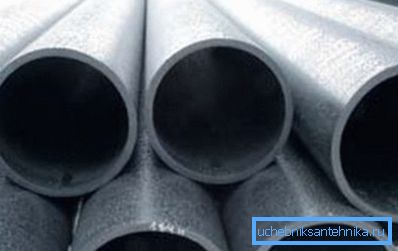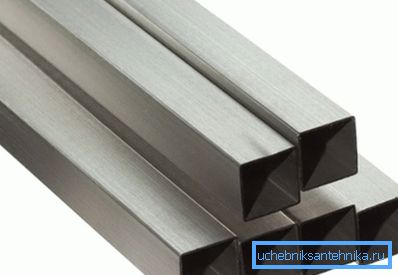Steel electric welded longitudinal pipes types and features
Steel longitudinal electric-welded pipes are one of the most common materials when laying gas pipelines, water pipes, heating systems and other pipelines. Next, we take a closer look at the features of these pipes, their types and areas of application.

Types of steel pipes
First of all, steel pipes can be of several types:
- Electrowelded - have a weld. This production method is the simplest and least expensive.
- Seamless - this type includes hot-rolled and cold-rolled products made from solid metal billets.. This technology is more complex and expensive, however, allows to obtain products with high accuracy of form and mechanical strength.

Electric products in turn are divided into two types:
- Spiral-seam - the seam does not have the appearance of a spiral. This method allows you to achieve good tensile strength.
- Electrowelded straight-seam - billet has a longitudinal seam. These products are more versatile and more common. With their use, most of the water lines are completed.

Special features
GOST 10705 91 for steel electrowelded longitudinal pipes allows their manufacture with a diameter of from 450 to 1420 mm.
In addition, there are four forms of their cross section:
- Square;
- Rectangular;
- round;
- Oval.
As a rule, the starting material for these products is strip - this is sheet metal or steel tape, which on special machines is bent into a tube.

According to GOST, this product is made of carbon and low alloy steel of the following types:
- Calm;
- Semi-calm;
- Boiling.
When choosing, it should be borne in mind that the characteristics of the range of these products are quite heterogeneous. Therefore, GOST 10706 76 for steel electrically-welded longitudinal welded pipes subdivides them into four groups:
| Group A | Includes products that are commonly used under high mechanical loads, for example, during construction. |
| Group B | They are resistant to chemical attack, therefore, they are used in the construction of pipelines for the transportation of various chemical substances. |
| Group B | Possess quality products of both of the above groups. |
| Group G | Products are highly resistant to external and internal pressure. |

Specifications
According to GOST 10704 91 for longitudinal electric-welded pipes, they may have the following parameters:
| Wall thickness | From 1 mm to 10 mm. Wall thickness is selected depending on the diameter. |
| Diameter | As mentioned above, this parameter ranges from 10 to 1420 mm. |
| Length | Unmeasured length with a diameter of less than 30 mm can be at least 2 meters, with a diameter of 30 - 70 mm, this parameter is at least 3 meters. With a diameter of 70 - 152 m - length is allowed from 4 meters, and more than 152 mm - from 5 meters and more. The dimensional length also depends on the diameter of the product. With a cross section of up to 70 mm, it is 5–9 m, and up to 219 mm - fluctuates within 6–9 m. According to GOST 10705 80 for longitudinal pipes with a diameter of up to 530 mm, for products with a cross section of 426 mm, the length range is within 10–12 m. Pipes of a larger diameter are only non-dimensional. |
These longitudinal pipes come in two accuracy classes:
- With trimming the ends - with this the burrs are removed.
- No trimming - no burrs will be removed.
According to GOST 10706 91 for this product, the maximum possible deviation of its length depends on the accuracy class. For the first class, this value is +15 mm, and for the second - +100 mm.

Merits
Among the advantages of electrically welded pipes are the following points:
- Extensive product mix due to production technology.
- The maximum diameter can be 1.4 meters (the wall thickness in this case is 32 mm), while the rolling analogues can have a diameter of not more than 550 mm.
- The weight of a steel electrically-welded longitudinal pipe is relatively small compared to the rolling analog, which simplifies transportation and installation.
- Good strength, which allows the pipeline to withstand mechanical stress and high internal pressure in the system.
- Larger volume with the same diameter, compared with rolling analogues. This allows pumping more gas into the pipelines.
- Low price, compared with other types of steel pipes.
Tip! The assembly of the pipeline is carried out using a welding machine. Having the skill to work with this tool, you can do the work yourself.
disadvantages
The disadvantages of products include:
- A rather high roughness coefficient due to the presence of a weld.
- Lower strength compared with rolling analogues, which is also due to the presence of the weld.

Production features
As mentioned above, the material for the manufacture of products of this type is a strip, which is supplied in the form of rolls.
Production technology is as follows:
- First of all, the material is prepared - unrolled and cut into strips.
- Then the strips are folded into a ribbon. It should be noted that this process is continuous, so this tape is also called endless.
- After that, on milling machines, a blank with an open seam and a circular cross section is formed from the tape.
- Next, the seam is welded by electric welding. Currently, there are four welding methods, each of which has its own advantages and disadvantages. When choosing a method, the priority is reliability and durability, since these indicators determine the class of the product.

- The finished product is calibrated, which allows to obtain the exact diameter and thickness of the walls.
- The weld is monitored using vortex points or ultrasound. This stage is very important, as the durability of the product depends on the weld.
- The final stage is the cutting of finished products into segments of the desired length, which are subsequently shipped to the warehouse.
Note! At the very end of the production process, the products are labeled. The product brand informs about its geometrical parameters, the type of construction material that was used, and the accuracy class of the production process.
GOST 10704 76 for this type of pipe controls their mechanical properties. At the same time, chemical control of products is not performed.

Application area
The scope of the products in question is quite extensive.
Most often it is used in the following areas:
- Water supply - can be used for hot and cold water supply, as the metal is not susceptible to temperature extremes and pressure. (See also the article Distribution of water pipes: features.)
- Heating systems - products are widely used in the construction of urban and local heating mains. Moreover, in cases where the temperature of the coolant exceeds 95 degrees Celsius, it is allowed to use only steel materials. In addition, the high ring stiffness and good resistance to longitudinal loads make such a pipe almost ideal riser for vertical wiring.
- Gas pipeline and oil pipeline - the popularity of the products in question in this industry is due to its resistance to a chemical aggressive environment and its ability to withstand high pressure (up to 16 MPa).
- Products belonging to the first class of accuracy are used in engineering and construction. True, in construction more often they use not round, but square pipes, since they have better strength and rigidity.
Note! The instruction for the installation of steel pipelines involves the preparation of edges at the joints when welding pipes, which allows to ensure the perfect joining of sections at a welded joint. If the wall thickness is more than 3 mm, the bevel angle should not exceed 45 degrees.
Here, perhaps, are all the main points that can be said about this type of pipe.
Conclusion
The electric welded longitudinal pipe is a universal product that is used in a variety of designs. The extensive scope of their application is associated with good performance and relatively low cost, compared with similar products.
From the video in this article, you can get more information on this topic.